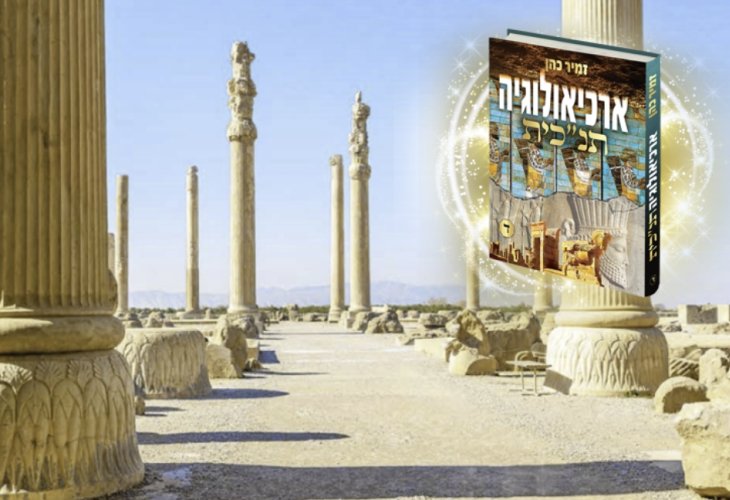Was King Ahasuerus Fit to Rule? Unearthing Insights from the Purim Story
Most historians associate King Ahasuerus from the Purim story with Xerxes I from ancient Persia. Dive into Rabbi Zamir Cohen's new book exploring the biblical and archaeological revelations about this king.
 Giant columns in the palace of the Persian and Median kings in Persepolis, Iran
Giant columns in the palace of the Persian and Median kings in Persepolis, IranWith the conquest of Babylon by the Persians, the exiled Jews came under Persian rule. Hence, the "Babylonian Exile" transitioned to the "Persian Exile." Historical sources and archaeological findings from the period indicate that Jewish life under the Persian government was relatively good.
This likely explains why, when King Cyrus granted permission to return to Israel, only a part of the exiles went with Ezra and Nehemiah in the return to Zion, while many chose to remain in exile. These Jews who did not return experienced up close the events recounted in the Book of Esther.
It should be noted that even in the days of King Cyrus, who announced the permission to return to Zion, Mordechai the Jew, mentioned in the Book of Esther, was one of the leaders of the Jewish people. He was a member of the Sanhedrin who went into exile during Nebuchadnezzar's reign, and he is listed in the Book of Ezra among the leaders who returned to Israel in the return to Zion.
With Cyrus's declaration, Mordechai rose to participate in building the Second Temple, and upon returning to Persia, the events of the Scroll took place. As various sources indicate, the return to Zion preceded the events recounted in the Book of Esther.
* * *
In the field of historical and archaeological research, the Book of Esther stands at the center of a fascinating study that has spanned over a century.
The Scroll tells of one of the kings of Persia and Media, King Ahasuerus, who had legendary wealth and resided in a complex containing many opulent palaces. Advised by Haman, his viceroy, Ahasuerus ordered the destruction of Jews living in the one hundred twenty-seven nations he reigned over. Eventually, through fasting, repentance, and prayer, and a brilliant move by Esther, the Jewish queen, the king sent Haman to the gallows and replaced him with Mordechai the Jew, canceling the decree.
The Scroll is rich in details related to that period, such as typical names of people, names of special tools, laws that were common then, period background, and more, allowing us to extract much information, alongside numerous discoveries in archaeological excavations that continue to this day.
Indeed, researchers have found in documents and excavations much material entirely consistent with the descriptions mentioned in the Scroll. These findings surfacing from the earth reveal before our eyes what the people of that era saw in those days, as the verse states: "Truth shall spring from the earth."
In this chapter, we will look at the major findings uncovered in the ruins of King Ahasuerus's magnificent palaces.
The King Ahasuerus
The Book of Esther introduces the king during whose reign the events it describes took place, specifying the boundaries of his kingdom:
"It was in the days of Ahasuerus, who ruled from India to Ethiopia, over one hundred and twenty-seven provinces."
Most historians identify the king in the Scroll with Xerxes I, known in Persian history, who ruled over the ancient Persian Empire (referred to by scholars as the Achaemenid Empire).
The name "Xerxes" appears on many archaeological findings of the period, pronounced in Persian in a specific manner, and slightly differently in Hebrew. It is noted that in the Scroll itself, the name of Ahasuerus is sometimes written as Ahasuerosh and once as Achashresh, yet always pronounced Ahasuerus. Besides the similarity between Xerxes and Ahasuerus, there are additional reasons for this identification, some of which we will discuss below.
The Greeks referred to Xerxes as Xerxes I, changing names as was their custom, often using the letter 's' in their language. Through this identification, we can extract important information about King Ahasuerus and his era from the writings of the ancient Greeks, who had extensive knowledge about him due to the bitter battles he waged against them at the head of his mighty army.
Historical sources indicate that Xerxes was the son of Darius but was not the crown prince, yet he managed to depose his predecessors and was crowned king. This information fits well with and settles the seemingly contradictory words of the sages. For in the Midrash and "Second Targum," Ahasuerus is mentioned as the son of Darius, while in the Talmud, it is written that Ahasuerus "ruled by himself - he wasn't suited for the monarchy, and it was through giving considerable wealth that he rose."
The Talmud was worded with great precision. It does not say Ahasuerus was not of royal seed, but that he was not fit for kingship. This means that he was not the natural candidate to be king; someone else preceded him, yet he succeeded in paving his way to the throne through significant bribery.
From the book "Biblical Archaeology Volume IV" by Rabbi Zamir Cohen, which was released this week. To purchase the book, click here.

